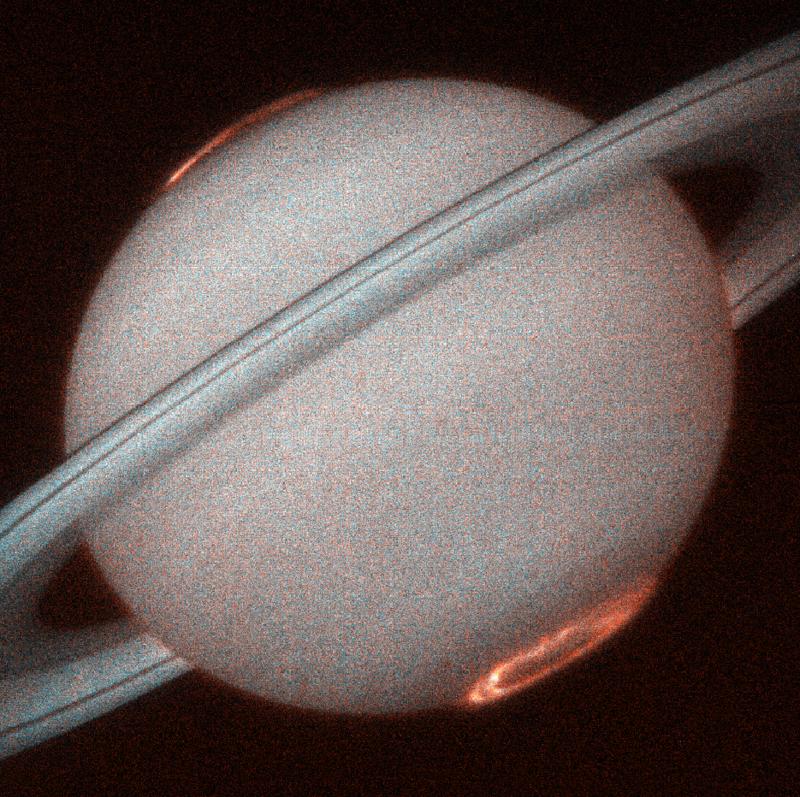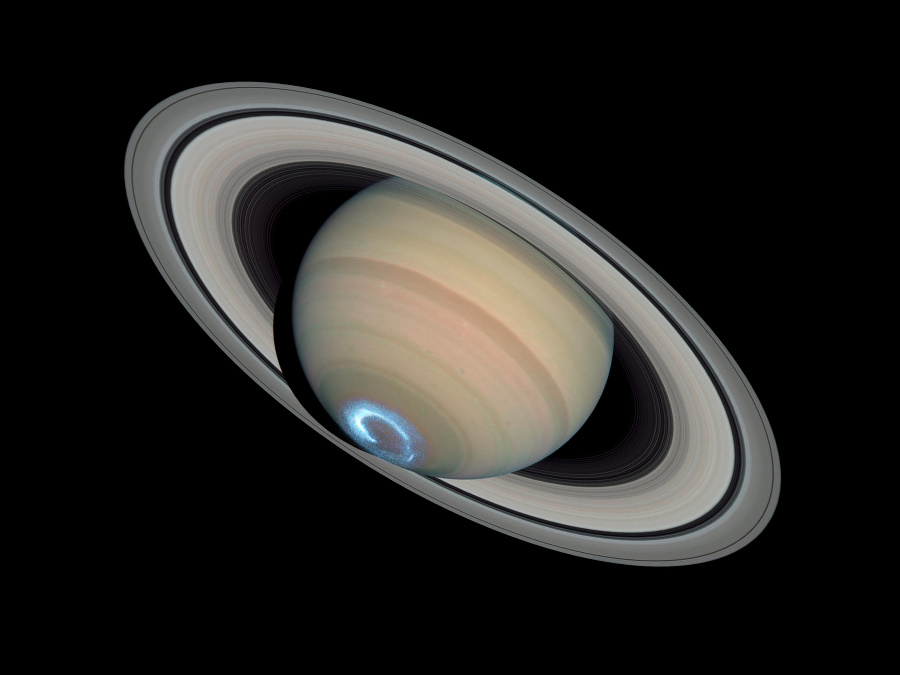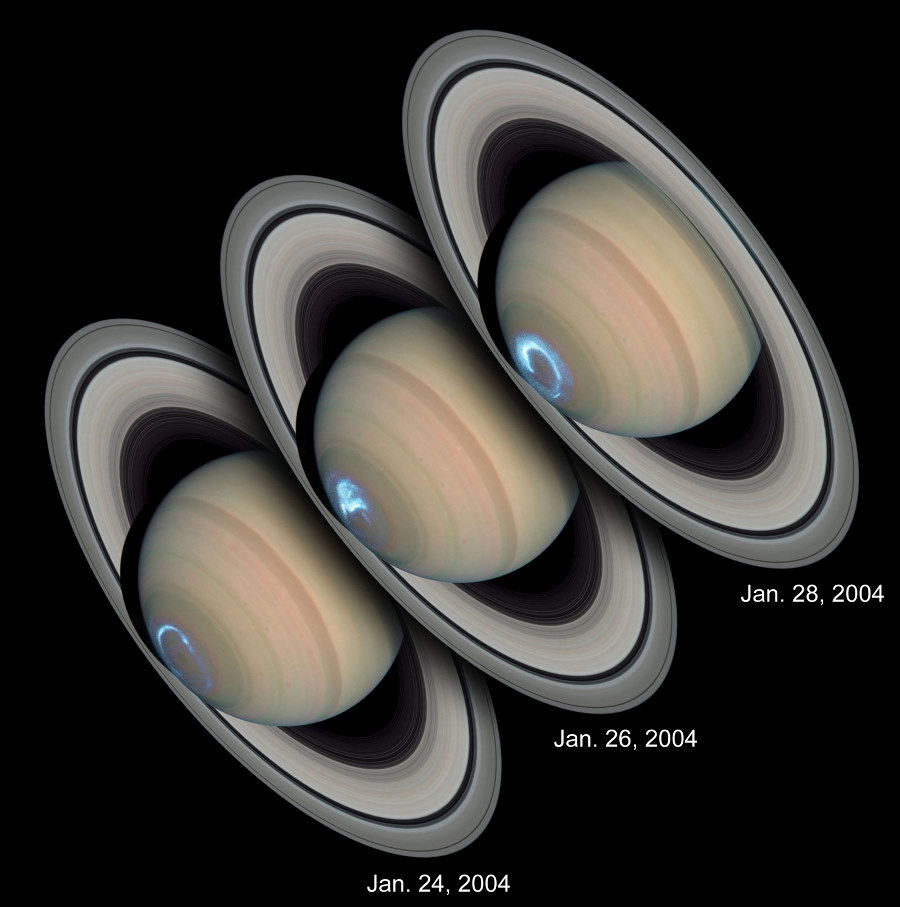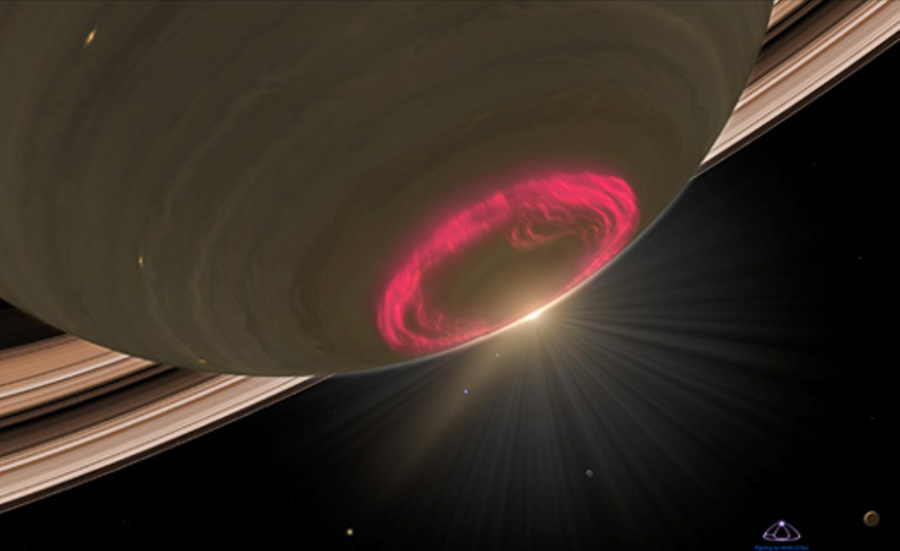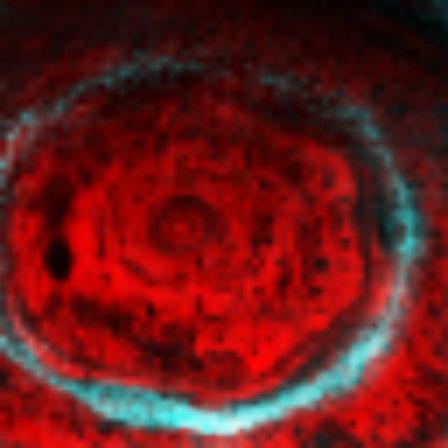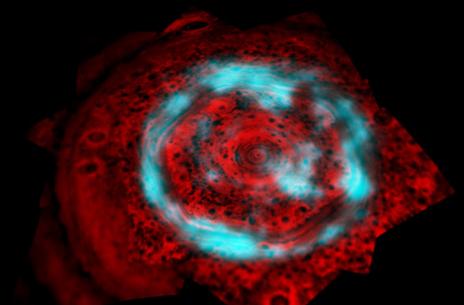|
The Enigmas on Saturn |
||
Credit: J T Trauger (JPL) and NASA |
||
|
|
||
|
||
| The ultraviolet image of the southern polar region of Saturn with its aurora was taken on January 28, 2004 by the Hubble Space Telescope's Imaging Spectrograph. The visible part of the image was taken by Erich Karkoschka of the University of Arizona using the telescope's Advanced Camera for Surveys on March 22, 2004. The ultraviolet image was transferred to the visible blue to show the geometry of the auroral display and superimposed upon the subsequently obtained visible image, as I understand it. - SOURCE | ||
|
||
| The
ultraviolet parts of these three superimposed
images were taken on January 24,26, and 28, 2004.
This shows the dynamic
nature of the auroral display. On Earth, auroral
storms may develop in
about 10 minutes last for a few hours, whereas
Saturn's auroral displays
always appear bright and may last for several days
(NASA).
"The observations, made by Hubble and the Cassini spacecraft, while enroute to the planet, suggest that Saturn's auroral storms are driven mainly by the pressure of the solar wind -- a stream of charged particles from the Sun -- rather than by the Sun's magnetic field. The aurora's strong brightening on Jan. 28, 2004 corresponds with the recent arrival of a large disturbance in the solar wind. The image shows that when Saturn's auroras become brighter (and thus more powerful), the ring of light encircling the pole shrinks in diameter." - SOURCE |
||
|
||
| While the blue representation of the auroral display is dramatic and appropriate, transferring the ultraviolet data to the nearest visible color, it is a little misleading in that it does not represent what the human eye would see from a nearby spacecraft. If the ultraviolet is excited, then one can be fairly confident that the visible spectra would also be excited. It would then be expected that the hydrogen of the atmosphere would give off the bright n=3->2 red emission known astronomically as the H-alpha line. The above is a NASA artist's conception of the visual phenomenon as observed by the human eye. The credit for this graphic is NASA, ESA and A. Schaller, STScI-PRC05-06b. The familiar visible hydrogen spectrum is shown at right. - SOURCE | ||
|
...
..
Saturn's northern aurora glows bluish-green in this color-coded infrared image. The planet's polar cloud patterns are shown in shades of red. Scientists say that the areas of auroral activity close to the pole shouldn't be there. .. by Alan Boyle Scientists say the northern lights on Saturn are unlike anything they've ever seen, on Earth or elsewhere in the solar system. Infrared imagery from the Cassini orbiter, released today to accompany research published in the journal Nature, only adds to the mystery at the top of the ringed planet. Saturn's north pole is already home to a bizarre six-sided cyclone that planetary scientists haven't yet figured out. That observation marked the first time a hexagon had been seen in atmospheric patterns. The northern auroral displays, monitored by Cassini's visual and infrared mapping spectrometer, also go against the conventional wisdom. On Earth and Jupiter, for instance, astronomers are used to seeing auroral arcs or rings of light - which glow when energetic particles stream along a planet's magnetic field and interact with the atmosphere. The auroras on Earth, also known as the northern or southern lights, are sparked by the solar wind. Jupiter's main auroral ring is powered by the planet's own magnetic processes. Saturn's main auroral ring, like Earth's, is caused by the solar wind. But the newly observed infrared displays go all over the place. "We've never seen an aurora like this elsewhere," the University of Leicester's Tom Stallard, lead author of the Nature paper, said today in a NASA news release. "It's not just a ring of aurorae like those we've seen at Jupiter or Earth. This one covers an enormous area across the pole. Our current ideas on what forms Saturn's aurorae predict that this region should be empty, so finding such a bright one here is a fantastic surprise." The Hubble Space Telescope has observed Saturn's ultraviolet aurora before, but the widespread infrared aurora wasn't seen because the region where it appears was hidden from Hubble's sight. Cassini, which has been circling Saturn and its satellites for more than four years, has had a much better view of the polar region. The northern infrared aurora has been seen to change size and intensity dramatically as the solar wind varies. Occasionally, it fades completely away, over a period of as little as 45 minutes. "Saturn's unique auroral features are telling us there is something special and unforeseen about this planet's magnetosphere and the way it interacts with the solar wind and the planet's atmosphere," said Nick Achilleos of the University College London, a member of the $3.5 billion Cassini mission's magnetometer team. "Trying to explain its origin will no doubt lead us to physics which uniquely operates in the environment of Saturn." For earlier intimations of Saturn's weird light shows, check out this report from New Scientist, based on research Nature published in June. For the latest about all of Saturn's mysteries, click on over to the Cassini mission's Web site at NASA's Jet Propulsion Laboratory. You might also enjoy learning more about Saturn's spooky southern hurricane. While you're at it, don't miss our "Best of Cassini" slide show. And did I mention that Mars, Uranus and Neptune have auroral displays as well? SOURCE: MSNBC |
||
| FAIR USE NOTICE: This page contains copyrighted material the use of which has not been specifically authorized by the copyright owner. Pegasus Research Consortium distributes this material without profit to those who have expressed a prior interest in receiving the included information for research and educational purposes. We believe this constitutes a fair use of any such copyrighted material as provided for in 17 U.S.C § 107. If you wish to use copyrighted material from this site for purposes of your own that go beyond fair use, you must obtain permission from the copyright owner. | ||
|
|
